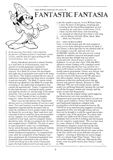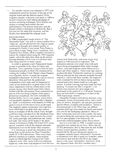

Disney had always planned to release fantasia as a road show at increased prices, since the amount of sound equipment required for Fantasound was beyond the budget of most cinemas. So a Mark IX system was developed and eight sets of equipment were used in the many road shows. This system included the two sets of auditorium loudspeakers but these had to switched in and out manually. The Mark X system which followed was identical to the Mark IX except that switching of the auditorium loudspeakers was carried out automatically. Disney's engineers had by this time devised a mechanical replay system activated by notches cut into the edge of the sound print film. This was the system installed in the Carthay Circle Theater for the Los Angeles premiere, where the film ran for 4-5 weeks. There were several reasons why Fantasound did not survive a limited number of runs as a road show. First and foremost was the huge amount of equipment required and the necessary time to make the installation which usually meant closing the theatre for several days. Each road show unit consisted of eleven amplifier racks and associated power supplies, two sound film phonographs modified to four track, and two complete selsyn distributor units. All this was packed into 45 cases and weighed almost 15.000lbs. The lack of space in many projection rooms was a contributing factor, and at the same time the coming of wartime conditions prohibited the manufacture of any further Fantasound equipment. To compound the issue, after the completion of the Fantasia road show programme the Fantasound equipment was dismantled and contributed to the war effort. Credit must be given to the whole Fantasound team who had worked hard for several years to make the system a success. It was William Garity who bore the brunt of designing, installing and maintaining all the rerecording equipment, as well as overseeing the road show installations. J.N.A. Hawkins was the chief music and rerecording mixer, assisted (at what must have been a very long console) by Messrs, Slyfield, Blinn, Steck, Marr, Perry, Moss and Hisserich. Fantasia is released Fantasia was the longest and the most expensive cartoon ever made sand drawn entirely by hand. It was Disney's showcase film for the talented staff on his company's payroll, and cost well over $2,000,000. Initially the film did not win critical appraise or audience approval and people stayed away because they thought that any movie connected with classical music would be too highbrow. It was not until April 1942 that RKO agreed to release Fantasia with a standard sound track, providing that the film was cut from two hours to 82 minutes so that it could form part of a double feature programme. Disney was furious, and would have nothing to do with any editing. This was the version first shown in the UK and was a box office disaster, mainly because English audiences at that time preferred action and spy movies with patriotic themes. Reissues in 1944, 1946 and 1953 met with similar results, and the studio was suffering financially because the war had cut off the European market and virtually half the studio income had disappeared. By this time the original nitrate sound negatives had deteriorated and were unusable but a Fantasound quad print had been preserved and was in fairly good condition. Disney had also kept back one Fantasound reproducer complete with preamplifiers which had escaped destruction. By 1955 RCA were manufacturing magnetic recording equipment for film and although Disney did not have any he thought it would be a good idea to have a magnetic copy of the quad print. So a three track transfer was made from the Disney studio down telephone lines to the RCA building and that became the new magnetic sound master. This was first used for a new release in 1956 in Superscope with Stereophonic magnetic sound and was the first version of Fantasound heard in British Cinemas. But the anamorphic picture did not suit some section of the film which were given different amounts of 'squeeze', resulting in stretched out screen images with very plump Sugar Plum Fairies! There were two further releases in 1963 and 1969 and the film finally went into profit shortly after Disney's death in 1966. Yet another version was released in 1977 with rechanneled sound but because of the age of the original sound and the dubious quality of the magnetic transfer, a decision was taken in 1984 to record a brand new track taking advantage of modern recording techniques. Irwin Kostal was chosen to arrange and conduct the new performances with session musicians, and the picture carried a dedication to Stokowski. But it was just not the same film anymore, and the Disney fans demanded the original score. Restoration In 1980 a particularly tough section of 'The Nutcracker Suite' was sent to various studios for a 'clean-up', and all advised that the original sound could not be brought up to theatre quality. It remained for Disney's own mixer Terry Porter to prove them wrong. Using Terry's expertise, Vice Chairman Roy Disney (Walt's nephew) decided to restore the original sound using the 1955 magnetic master, and at the same time clean up the picture printing elements which were in a perilous state after being used for so many copies. In order to generate a new Fantasound master as near as possible to the ideas of Garity and Hawkins, Terry started by trying to find out how Fantasound actually worked. He commenced by visiting the Carthay Circle Theater where Fantasia was originally shown, to study the original loudspeaker placement. At first he was at a loss to determine when and how the auditorium loudspeakers were used, until he happened to come across Stokowski's original score in the music department with his written notes in the margin saying what should come from where. Armed with this information Terry assembled his gear as if he was doing a regular clean upon a production soundtrack. His tools included the familiar Dolby Cat 43, a de-popper, notch filters and parametric equalisers. Since today's theatres are 'dead' in comparison with theatres of 1940, he used a Lexicon reverb unit to liven up the track. The magnetic master contained very high hiss level which had to be dealt with; also various hums in multiples of 60 Hz which Terry thought could have been introduced by the telephone lines. Terry used a 70mm six track recorder for screen left, centre and right, and auditorium left, centre and right. The result can be heard in the latest release of Fantasia in Dolby SR.D and SVA stereo optical, complete with all the original surround information even on the home video cassettes. It is interesting to recall the restoration work being done on the picture by Peter Comandini, owner of YCM Laboratories. There were many different elements to examine, some original negatives which had been laying in the vaults forgotten since 1941, some well worn duplicate negatives, some three strip negatives from the live scenes with Stokowski, and some single strip negatives with successive exposures. The animation cameras were single strip with each frame being photographed three times through yellow, cyan and magenta colour filters on to a black and white negative. These were later used to produce the three Technicolor matrices for printing. Having selected the best material available for each sequence, which took three months, the negatives were examined for defects before being machine cleaned and a new master made on a wet gate printer. A colour interneg was then made for final printing. To ensure the film's original 1:1.33 format was retained, this ratio image was positioned in the centre of a 1:1.85 print. Fantasia does not lend itself to cropping as evident in the 1956 Superscope version. Altogether Fantasia used eleven directors, sixty animators, twenty background artists, and a small army of writers, designers, ink and pen personnel, special effects, sculptors and modellers - almost a thousand people in all. More than one million separate drawings were made (by hand) and turned into cels for the multiplane animation. Many of these technicians received screen credits, the main exception being the cameraman who carried out all the live photography with Stokowski, the renowned cinematographer James Wong Howe. Just two years later in 1992, a similar clean up operation was carried out on Snow White also by YCM Laboratories. But by that time the new Kodak Cineon system had been installed, which transferred the 56 year old picture negative to computer readable binary information. Numerous workstations were able to paint out scratches, detect and remove dust and dirt and fill in any empty spaces with visual information 'borrowed' from any adjacent frame. But that's another story!